The Great Subscription Trap: How Streaming Broke Its Promise and What It Means for Everything Else
Streaming platforms broke their convenience promise, making piracy easier than legal options. Why subscription fatigue is spreading across all industries.
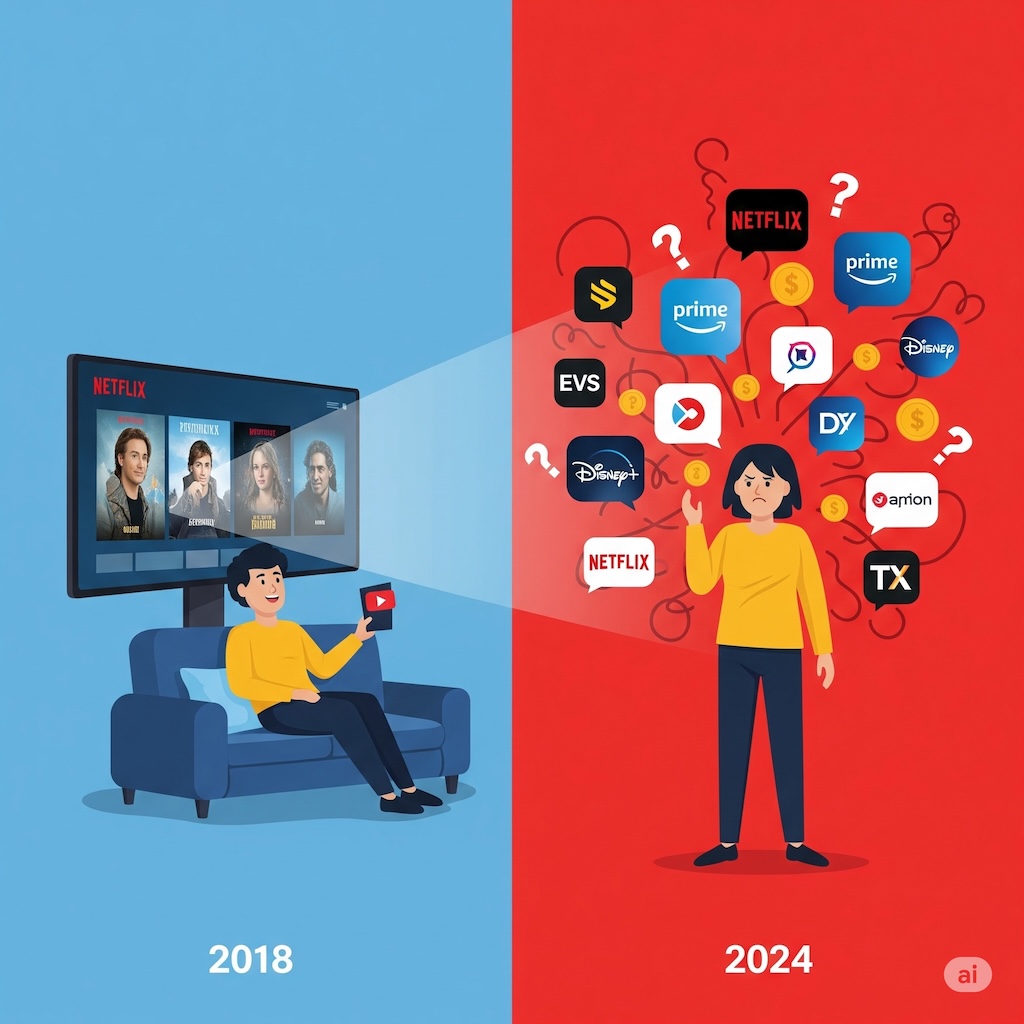
Summary
I've been tracking my own subscription frustration for months, and the math is revealing something troubling. When I want to watch a specific show today, the legal route often takes more effort than piracy - completely reversing the convenience equation that made streaming successful. This isn't just about entertainment; it's a preview of what's happening across every industry adopting subscription models, and the implications go far beyond monthly fees.
Key Points
- The convenience gap between legal and illegal options has disappeared, with streaming requiring more effort than piracy for many specific shows
- Subscription costs have increased 3-5x while content availability per platform has decreased dramatically from 90% to 30-40%
- The same venture-funded disruption pattern is repeating across industries: undercut with cheap prices, achieve dominance, then monetize convenience behind paywalls
- Consumer ownership is being systematically replaced with rental models that increase long-term costs while reducing control
- Open source alternatives are gaining traction as people actively seek subscription-free workflows
Key Takeaways
- Businesses need to recognize that convenience, not subscription models, drives customer loyalty - when subscriptions create friction, they defeat their own purpose
- The current trajectory toward universal subscriptions isn't sustainable and will likely trigger an ownership backlash
- Hybrid models offering both ownership and rental options may provide the balance needed for long-term sustainability
Lately, every time I read about a new show, I find myself doing something I thought I'd never do again: calculating whether it's worth the hassle to just torrent it instead.
That sentence would have sounded ridiculous to me five years ago. Back then, streaming felt like the perfect solution to an old problem. Pay ₹599 for Netflix, get access to 90% of the shows I wanted, no ads, no hassle. The convenience factor was everything - no more spending 30-45 minutes hunting for decent torrents, waiting for downloads, or worrying about malware.
But somewhere along the way, streaming platforms forgot what made them successful. And in doing so, they've created a blueprint that's now being copied across every industry, with troubling consequences for all of us.
When the Convenience Equation Flipped
Here's my actual process now when I want to watch something specific:
- Check Netflix - not there
- Check Amazon Prime - available for ₹149 rental even though I'm already paying for Prime
- Check Disney+ Hotstar - need the premium plan for HD quality
- Check Apple TV+ - not available in India
- Check local platforms - requires another subscription signup
- Finally search "show name torrent 4K"
The effort calculation completely flipped. What used to take 30 seconds now takes 10-15 minutes of platform hopping. Meanwhile, a torrent search takes the same time, and with current internet speeds, downloading a full season in 4K takes maybe 10-15 minutes total.
The convenience gap disappeared, but the dependency remained.
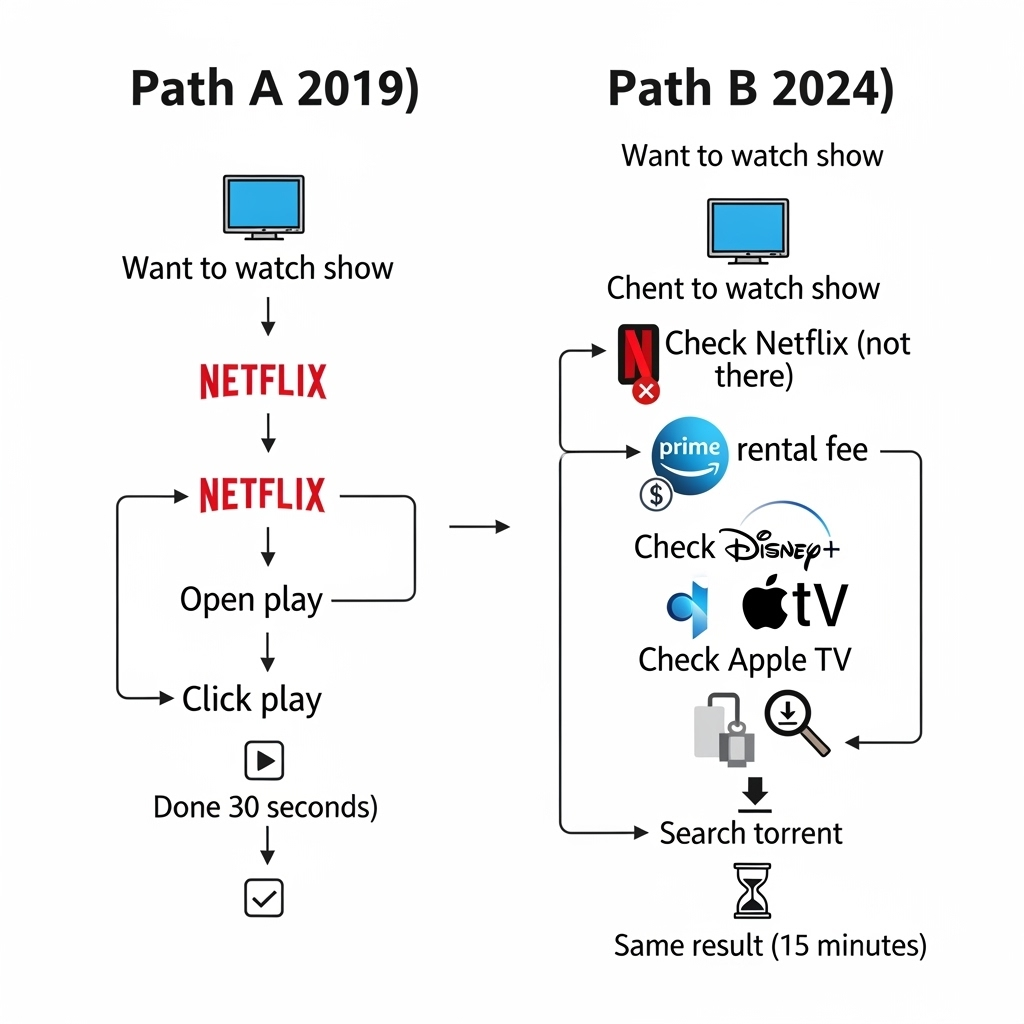
The Numbers Tell a Different Story
Recent industry data confirms this isn't just personal frustration. According to research, 62% of streaming subscribers now say there are too many options. The average person maintains 3.6 paid subscriptions, spending ₹3,000-5,000 monthly - more than many paid for cable.
But here's what's really telling: video piracy has increased 12-36% since 2020. When researchers ask why, 75% of pirates say they'd use legal services if they were more affordable and convenient.
This mirrors exactly what happened during the transition from physical media to streaming. People didn't pirate because they wanted to steal - they pirated because the legal option became more complicated than the illegal one.
My value equation used to be simple: ₹599 for Netflix with 90% of desired content. Now it's ₹799 for better quality with maybe 30-40% of shows, requiring 3-4 additional subscriptions. Total cost increased 3-5x while value decreased dramatically.
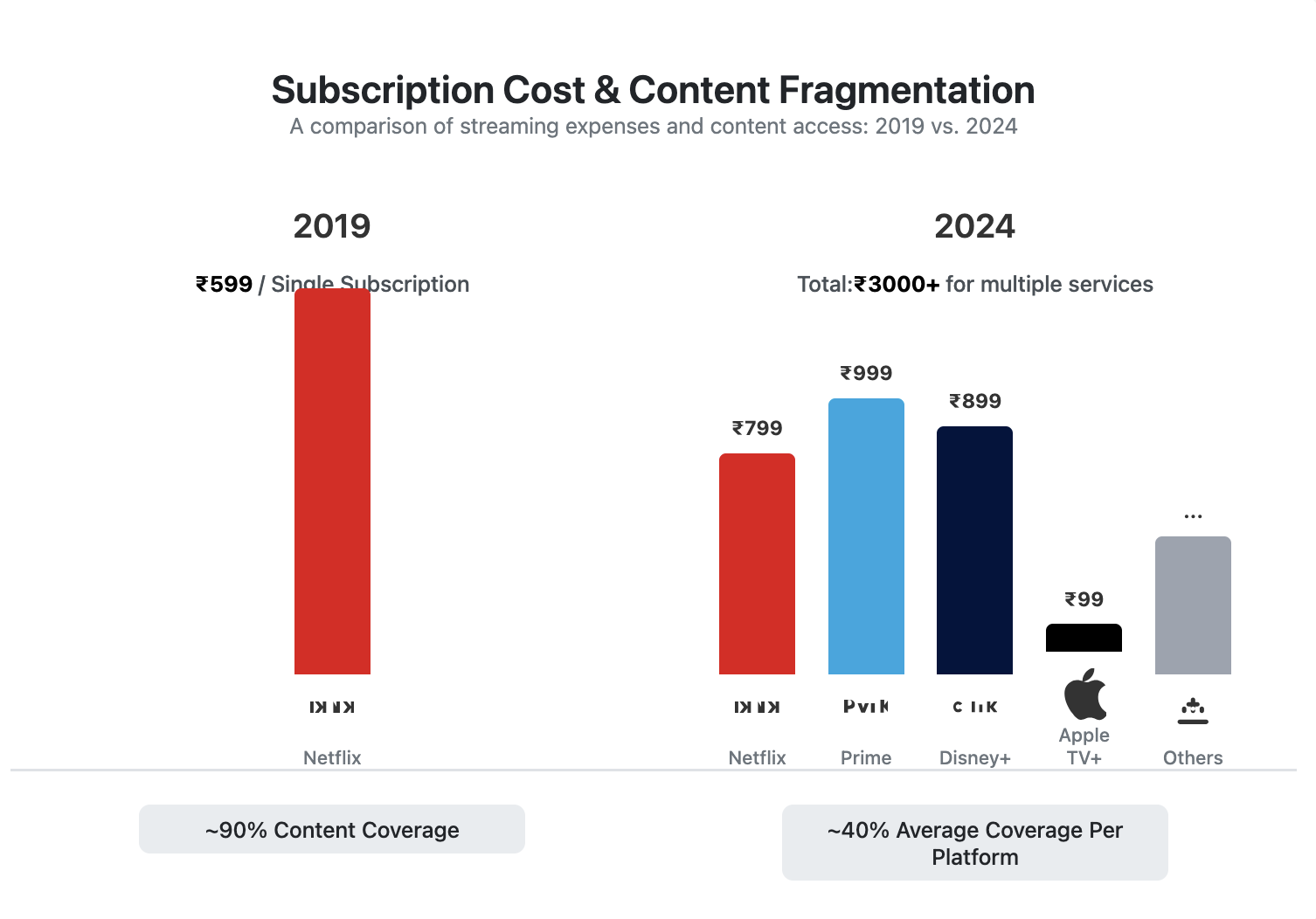
The Venture Capital Disruption Playbook
What's happening with streaming follows a predictable pattern I've observed across industries. Here's how it works:
Phase 1: The Undercut Use venture funding to offer services below cost, killing traditional competitors. Streaming platforms did this to cable. Food delivery did this to restaurants and traditional delivery. Ride-sharing did this to taxis.
Phase 2: Market Capture
Achieve dominance while competitors shut down or become irrelevant. Users get addicted to the convenience and low prices.
Phase 3: The Monetization Squeeze Once alternatives are eliminated, gradually increase prices and add subscription tiers for features that were previously included. The very convenience that attracted users gets moved behind additional paywalls.
Swiggy and Zomato now offer subscription plans promising "free delivery" - charging extra for what used to be their core value proposition. Ola and Uber have premium subscriptions for better availability and discounts. It's ironic that the features people originally used these platforms for are now premium add-ons.
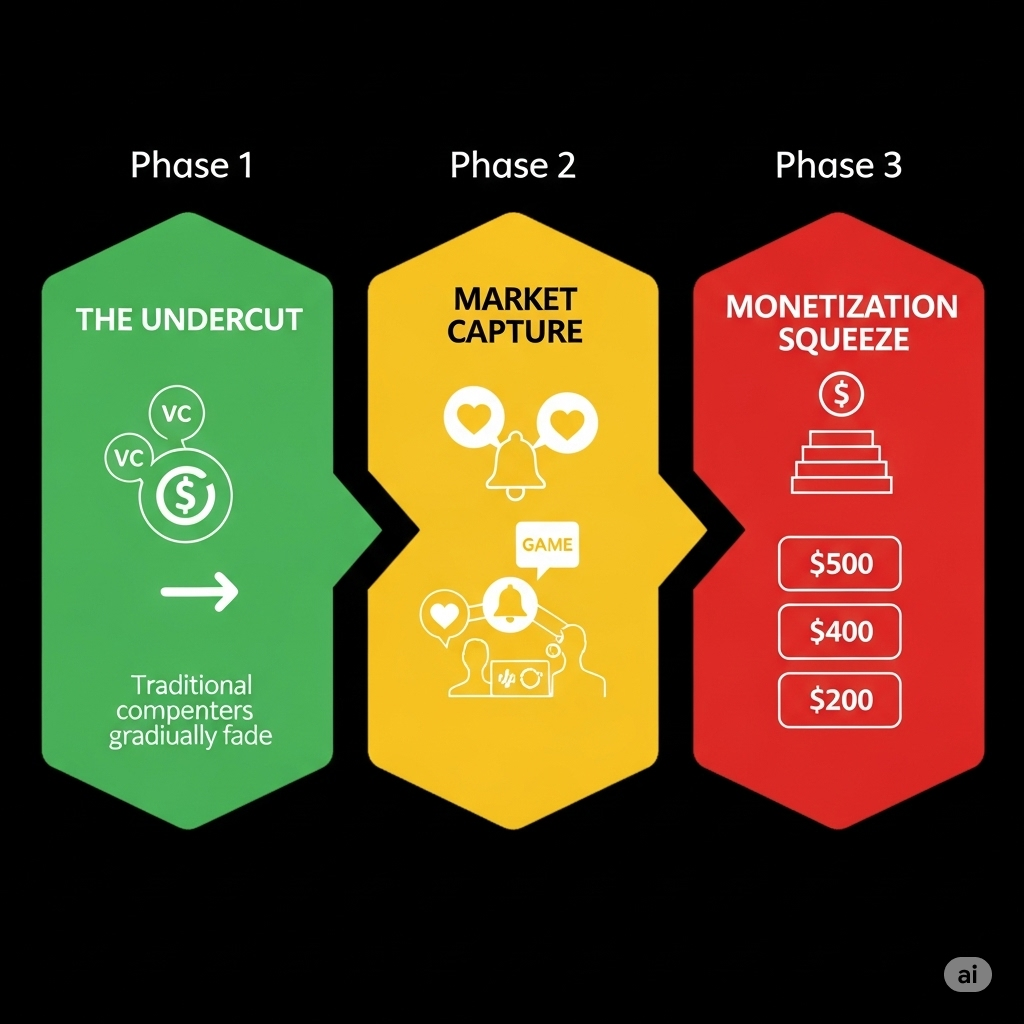
Beyond Entertainment: The Everything-as-a-Service Problem
Take Adobe Lightroom, which I've used for years. You could buy it for ₹9,000 and use it indefinitely with enough features for 99% of photography needs. Now it's ₹600 monthly, forever. Even casual photographers end up paying ₹7,200 annually - more than the old lifetime price - for software they might use sporadically.
This shift from ownership to rental has hidden costs beyond money. There's the mental overhead of subscription management, the dependency on continued payments, and the loss of control over tools you rely on.
I've started using open source alternatives wherever possible. GIMP instead of Photoshop. LibreOffice instead of Microsoft 365. These handle 99% of my needs without subscription hassles. YouTube is filled with videos about "subscription-free workflows" that get millions of views. People are actively seeking ways to own their tools again.
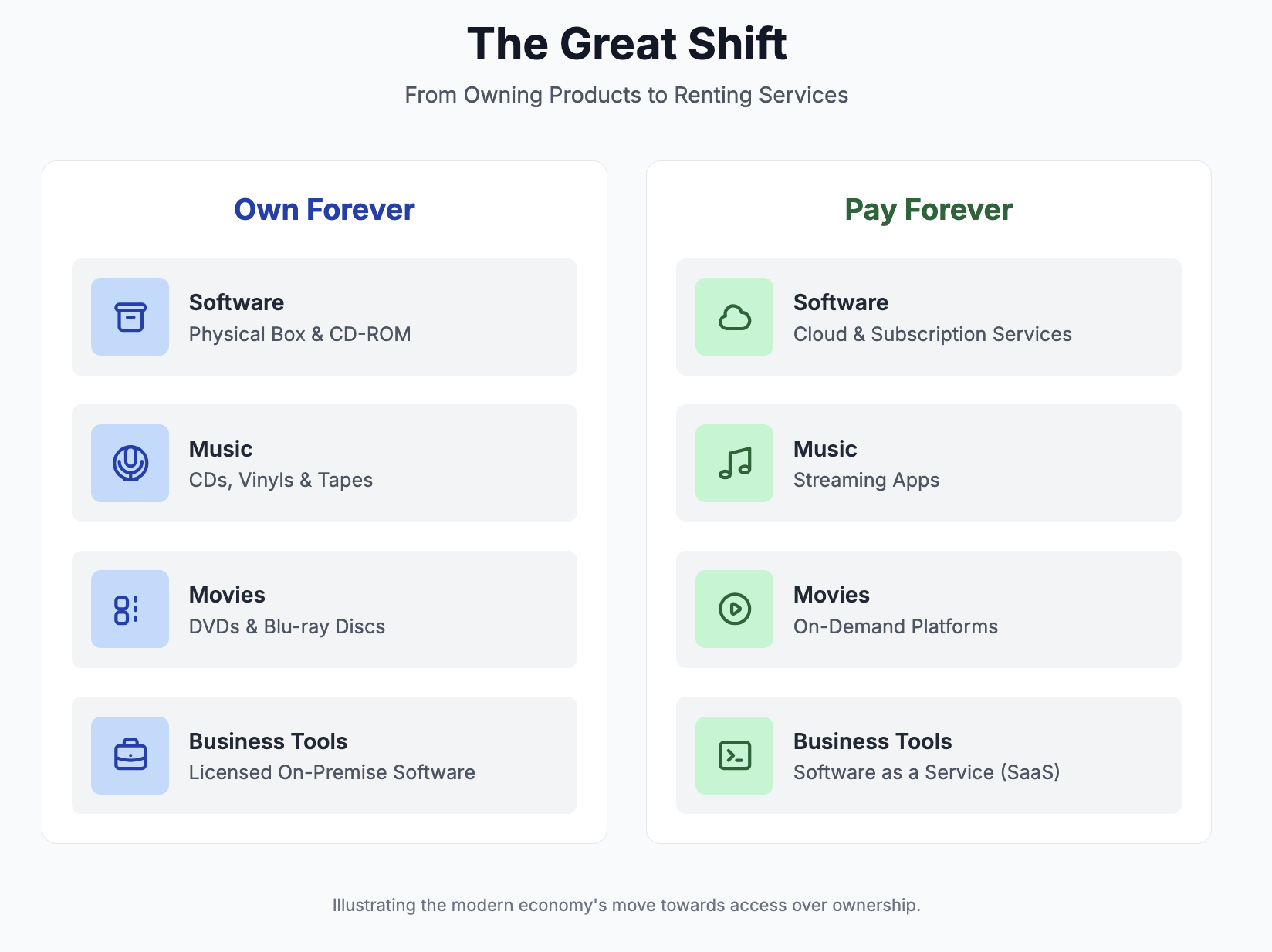
What the Data Reveals About User Behavior
The return to piracy isn't about wanting free content - it's about efficiency. When I want to watch something for an hour, spending 15 minutes hunting across platforms plus dealing with subscription management doesn't make sense. The same effort gets me the content through alternative means.
This creates a new form of digital inequality. Those who can afford multiple subscriptions get the full experience. Those who can't are pushed toward either going without or finding alternative means.
The streaming platforms set value expectations that they're now breaking. We paid to avoid ads, but ads are returning. We paid for convenience, but convenience is disappearing behind multiple subscription walls.
The Business Reality Behind the Squeeze
I understand the business context. Content creation costs have skyrocketed. Platforms invest billions in original content. The math of sustainable pricing is challenging when not everyone will pay premium rates.
But businesses are missing something crucial: convenience was never about subscription models themselves. It was about reducing friction between wanting something and getting it. When subscriptions create new friction - platform hunting, subscription management, price increases - they defeat their own purpose.
Potential Solutions Worth Exploring
The current system acknowledges it's broken. Maybe platforms could offer micro-payments for specific content - say ₹10 for a season available for 90 days. This could be complicated to implement but addresses the core frustration of paying full subscription fees for minimal usage.
A hybrid model might work better: basic ownership of core functionality with optional subscriptions for premium features. Some companies are experimenting with "lifetime" purchases alongside monthly options, creating clear value separation between owned and rented features.
The key is remembering what made streaming successful originally: giving people what they want, when they want it, without unnecessary friction.
What Happens Next
We're approaching a tipping point. Just as the music industry adapted when piracy made their model unsustainable, the broader digital economy needs new approaches.
I predict three main responses:
The Pirates' Renaissance: Modern pirate sites already offer better user experiences than many legal platforms - no geographical restrictions, unified search, no subscription management.
The Open Source Revolution: When "free" software costs hundreds monthly, learning alternatives becomes worthwhile. The community around subscription-free tools is growing rapidly.
The Ownership Backlash: Eventually, companies will compete on permanent ownership again. "Buy once, use forever" will become a competitive advantage when everyone else charges monthly.

The Broader Pattern
This isn't just about streaming or software. Every industry moving to subscriptions should ask: Are we making customers' lives easier, or just making our revenue more predictable?
The subscription economy promised convenience and continuous updates. What it often delivers is dependency and price increases. When rental models prioritize extraction over value, they become indistinguishable from the problems they were supposed to solve.
People will always find the path of least resistance. The question is whether businesses want to provide that path or force customers to find alternatives.
Because if there's one thing the return of piracy teaches us, it's that convenience beats everything else - including legality - when the gap becomes too wide.

Frequently Asked Questions
Q: Aren't you just advocating for piracy?
Not at all. I'm pointing out that when legal options become as effortful as illegal ones, people naturally choose the path of least resistance. The solution isn't to make piracy harder - it's to make legal options more convenient again.
Q: Don't content creators deserve to be paid for their work?
Absolutely. But the current fragmented subscription model might actually hurt creators by driving people away from legal platforms. A more convenient legal system could potentially generate more revenue through higher participation rates.
Q: Isn't this just the natural evolution of digital markets?
The pattern of using VC money to undercut competitors, then monetizing convenience once alternatives are eliminated, feels more like market manipulation than natural evolution. Sustainable business models should create value, not extract it after eliminating choice.
Q: What about the benefits of continuous updates and cloud features?
These are valuable for many users. The issue isn't with subscription models themselves, but with forcing everyone into them. Hybrid models could offer both ownership and subscription options based on individual needs.
Q: How can businesses maintain profitability without subscriptions?
Many successful businesses operate on one-time purchase models with optional premium services. The key is being honest about costs and value rather than using subscriptions to hide true pricing.
Q: Won't piracy hurt the industry long-term?
History suggests the opposite. The music industry grew stronger after adapting to piracy with convenient legal alternatives like Spotify. The current surge in video piracy is a signal that the legal alternatives need improvement, not that piracy is inherently preferred.
What subscription frustrations are you experiencing in your industry? Are you seeing the same convenience-to-complexity shift in your business tools? The pattern seems to be everywhere once you start looking for it.